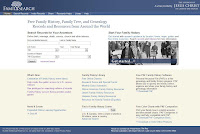I recently was invited to attend the very first FamilySearch Blogger Day where 12 bloggers from around the country were gathered here in Salt Lake City to learn more about this and other questions. We, in turn, were given the opportunity to blog about our day and some of the exciting things for the future of FamilySearch. FamilySearch was established and is operated by The Church of Jesus Christ of Latter-day Saints.
Jay Verkler, President of FamilySearch asked us this very question – “Who is FamilySearch?” and explained how to think about them.
Over the years genealogists and family historians have all used FamilySearch. And, since the parts and pieces of FamilySearch are currently spread around on a variety of websites and physical locations, let’s take a look at the bigger picture.
FamilySearch is a competitor of other sites like Ancestry.com and Footnote.com.
FamilySearch is dedicated to the discovery of existing records from around the world, preserving those records, and providing worldwide access to the records in much the same fashion as other websites.
FamilySearch is a Library.
The Family History Library in Salt Lake City was founded in 1894 and has been gathering records and assisting family historians with research for over a century. It’s the largest library of its kind in the world and averages about 1,500 visits every day. It includes about 2.5 million rolls of microfilmed records; over 700,000 microfiche; over 360,000 books and other publications; and almost 4,000 electronic resources.
Genealogical records that have been gathered and preserved by FamilySearch have been located at FamilySearch Record Search Pilot. Recently however, these records have been added to the FamilySearch Beta website. Both are currently available but the Record Search Pilot site is no longer being updated and eventually will be eliminated when additional features have been completed in the new site. Additional records are only being added to FamilySearch Beta. All records at FamilySearch are provided free-of-charge to the public unless restrictions have been placed on specific records by the original document owner.
Most all the original microfilmed records (3.5 billion images) have been stored for decades in the Granite Mountain Vault, buried deep in the Granite Mountain in Utah. You can read more about the vault in my post: Granite Mountain Records Vault and Indexing.
FamilySearch is a Digitization company.
FamilySearch is a Website.
The original FamilySearch.org website had its humble beginning in May of 1999 – a meer 11 years ago (even though the first computer program for FamilySearch was created in 1969). Within the first six months a total of 640 million entries could be accessed and there was over 1.5 BILLION hits. The website has undergone major changes and additions of records, and it is still growing and changing.
The first beta test of new FamilySearch began in November 2005. Four years later the website became available to all LDS Church members worldwide, except for Asian temple districts. New FamilySearch is still in its beta form and will eventually “go live” and be made available to everyone in the world with computer access.
 The original FamilySearch.org website is still currently being used. It is made up of many different sources of data, including the Ancestral File which is a database of family submitted family group sheets and lineage-linked pedigrees. Most of them were submitted up through the early 1970s. Since then, pedigrees have been submitted electronically from people throughout the world and are included in the Pedigree Resource Files (PRFs). Those PRFs are available on purchased CD’s and free at many of the Family History Centers and libraries around the world. Only about the first 75 CDs (about 130 total) of compiled data are included in new FamilySearch. Many of the pedigrees in the CD versions contain much more information than what is included online – mainly sources, notes and possibly living individuals and contact information.
The original FamilySearch.org website is still currently being used. It is made up of many different sources of data, including the Ancestral File which is a database of family submitted family group sheets and lineage-linked pedigrees. Most of them were submitted up through the early 1970s. Since then, pedigrees have been submitted electronically from people throughout the world and are included in the Pedigree Resource Files (PRFs). Those PRFs are available on purchased CD’s and free at many of the Family History Centers and libraries around the world. Only about the first 75 CDs (about 130 total) of compiled data are included in new FamilySearch. Many of the pedigrees in the CD versions contain much more information than what is included online – mainly sources, notes and possibly living individuals and contact information.Also included in the original FamilySearch is the IGI or International Genealogical Index which contains over 600 million names of deceased people from throughout the world, extracted or submitted by LDS Church members. Many of these names serve as an index to civil vital records and church records which include births, christenings/baptisms and marriages.
The original FamilySearch website rounds itself out with the Social Security Death Index, three Census Collections, and Vital Records Indexes for Mexico and Scandinavia.
Eventually, all of the different websites that make up the FamilySearch umbrella will become one single site. Until then, it helps to understand just what all these “mini” sites consist of and where they are located. There are many more tools available in FamilySearch and its latest version, Beta.FamilySearch.org, to help you in your quest to discover new family records. I’ll cover these in future posts.
So as we have discovered, FamilySearch is all of these things. It is strong, robust, and provides an enduring legacy of our heritage. It will still be around in its evolving form for 100’s of years.




Very good explanation. Thanks
ReplyDelete